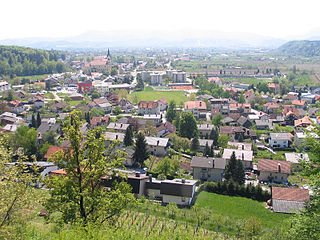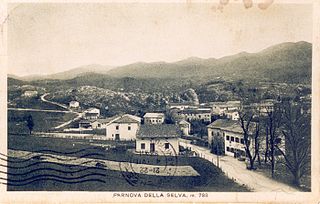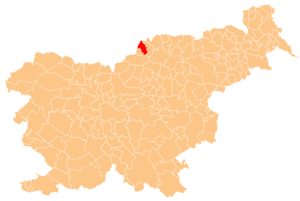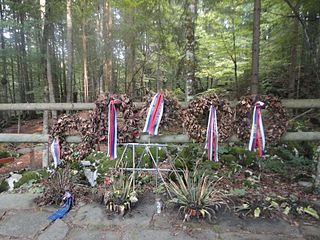
Velike Lašče is a town in Slovenia. It is the seat of the Municipality of Velike Lašče. It is part of the traditional region of Lower Carniola and is now included in the Central Slovenia Statistical Region.

Vojnik is the largest settlement and the centre of the Municipality of Vojnik in eastern Slovenia. It lies on the Hudinja River, north of Celje. Traditionally the area was part of the Lower Styria region. The municipality is now included in the Savinja Statistical Region.

Medlog is a settlement in the City Municipality of Celje in eastern Slovenia. It lies on the western outskirts of Celje. The grass runway of Celje Airport is located in the western part of the settlement. The area was traditionally part of the Styria region. It is now included with the rest of the municipality in the Savinja Statistical Region.

Trnovo is a village in western Slovenia in the Municipality of Nova Gorica. It is located on the high Trnovo Forest Plateau in the traditional Slovene Littoral region.

Voglarji is a dispersed settlement in the Municipality of Nova Gorica in western Slovenia. It is located on the high Trnovo Forest Plateau, overlooking the Vipava Valley. Voglarji includes the hamlets of Zavrh and Cvetrež.

Pameče is a settlement in the City Municipality of Slovenj Gradec in northern Slovenia. The area was traditionally part of Styria. The entire municipality is now included in the Carinthia Statistical Region.

Podgorje is a settlement that is a now a suburb of the town of Kamnik in the Upper Carniola region of Slovenia.

Dolenje pri Jelšanah is a village north of Jelšane in the Municipality of Ilirska Bistrica in the Inner Carniola region of Slovenia, next to the border with Croatia. The settlement includes the hamlets of Dolnji Kraj, Gornji Kraj, and Vrh Žloštajna.

Dolnji Zemon is a small settlement on the left bank of the Reka River south of Ilirska Bistrica in the Inner Carniola region of Slovenia. It includes the hamlet of Zemonska Vaga.

Harije is a village in the hills west of Ilirska Bistrica in the Inner Carniola region of Slovenia.

Jelšane is a village in the Municipality of Ilirska Bistrica in the Inner Carniola region of Slovenia, right on the border with Croatia. The Jelšane international border crossing between Slovenia and Croatia is just south of the village.

Novokračine is a village east of Jelšane in the Municipality of Ilirska Bistrica in the Inner Carniola region of Slovenia on the border with Croatia.

Kozarišče is a village south of Stari Trg pri Ložu in the Municipality of Loška Dolina in the Inner Carniola region of Slovenia. The area of the village extends south of the main settlement right to the Snežnik Plateau and to the border with Croatia. Snežnik Castle, a 13th-century castle, is located just southwest of the village.

Selovec is a dispersed settlement in the hills south of Dravograd in the Carinthia region in northern Slovenia.

Veliki Kamen is a settlement northeast of Senovo in the Municipality of Krško in eastern Slovenia. The area was traditionally part of Styria. It is now included with the rest of the municipality in the Lower Sava Statistical Region.

Sajevce is a small settlement on the left bank of the Krka River in the Municipality of Kostanjevica na Krki in eastern Slovenia. The area was traditionally part of Lower Carniola and is now included in the Lower Sava Statistical Region.

Ravenska Vas is a settlement immediately east and southeast of Zagorje ob Savi in central Slovenia. The area is part of the traditional region of Upper Carniola. It is now included with the rest of the municipality in the Central Sava Statistical Region.

Polajna is a small settlement in the Municipality of Zreče in northeastern Slovenia. It lies on the main road from Zreče to Vitanje. The area was traditionally part of Styria and is now included with the rest of the municipality in the Savinja Statistical Region.

Novo Tepanje is a settlement in the Municipality of Slovenske Konjice in eastern Slovenia. It lies on the regional road from Slovenske Konjice to Slovenska Bistrica on the left bank of Oplotnica Creek, a left tributary of the Dravinja River. The area is part of the traditional region of Styria. The municipality is now included in the Savinja Statistical Region.

Pečje is a settlement in the Municipality of Sevnica in central Slovenia. It lies just east of Sevnica above the left bank of the Sava River The area is part of the historical region of Styria. The municipality is now included in the Lower Sava Statistical Region.



















